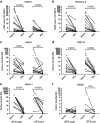Noncontaminated dietary oats may hamper normalization of the intestinal immune status in childhood celiac disease
- PMID: 24964993
- PMCID: PMC4077043
- DOI: 10.1038/ctg.2014.9
Noncontaminated dietary oats may hamper normalization of the intestinal immune status in childhood celiac disease
Abstract
Objectives: Life-long, strict gluten-free diet (GFD) is the only treatment for celiac disease (CD). Because there is still uncertainty regarding the safety of oats for CD patients, the aim was to investigate whether dietary oats influence the immune status of their intestinal mucosa.
Methods: Paired small intestinal biopsies, before and after >11 months on a GFD, were collected from children with CD who were enrolled in a randomized, double-blind intervention trial to either of two diets: standard GFD (GFD-std; n=13) and noncontaminated oat-containing GFD (GFD-oats; n=15). Expression levels of mRNAs for 22 different immune effector molecules and tight junction proteins were determined by quantitative reverse transcriptase (RT)-PCR.
Results: The number of mRNAs that remained elevated was higher in the GFD-oats group (P=0.05). In particular, mRNAs for the regulatory T cell (Treg) signature molecules interleukin-10 (IL-10) and transforming growth factor-β1 (TGF-β1), the cytotoxicity-activating natural killer (NK) receptors KLRC2/NKG2C and KLRC3/NKG2E, and the tight junction protein claudin-4 remained elevated. Between the two groups, most significant differences were seen for claudin-4 (P=0.003) and KLRC3/NKG2E (P=0.04).
Conclusions: A substantial fraction of pediatric CD patients seem to not tolerate oats. In these patients, dietary oats influence the immune status of the intestinal mucosa with an mRNA profile suggesting presence of activated cytotoxic lymphocytes and Tregs and a stressed epithelium with affected tight junctions. Assessment of changes in levels of mRNA for claudin-4 and KLC3/NKG2E from onset to after a year on oats containing GFD shows promise to identify these CD patients.
Figures





References
-
- Sollid LM. Coeliac disease: dissecting a complex inflammatory disorder. Nat Rev Immunol. 2002;2:647–655. - PubMed
-
- Di Sabatino A, Corazza GR. Coeliac disease. Lancet. 2009;373:1480–1493. - PubMed
-
- Green PH, Cellier C. Celiac disease. N Engl J Med. 2007;357:1731–1743. - PubMed
-
- Castellanos-Rubio A, Santin I, Irastorza I, et al. TH17 (and TH1) signatures of intestinal biopsies of CD patients in response to gliadin. Autoimmunity. 2009;42:69–73. - PubMed
LinkOut - more resources
Full Text Sources
Other Literature Sources
Medical
Research Materials

